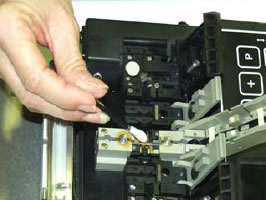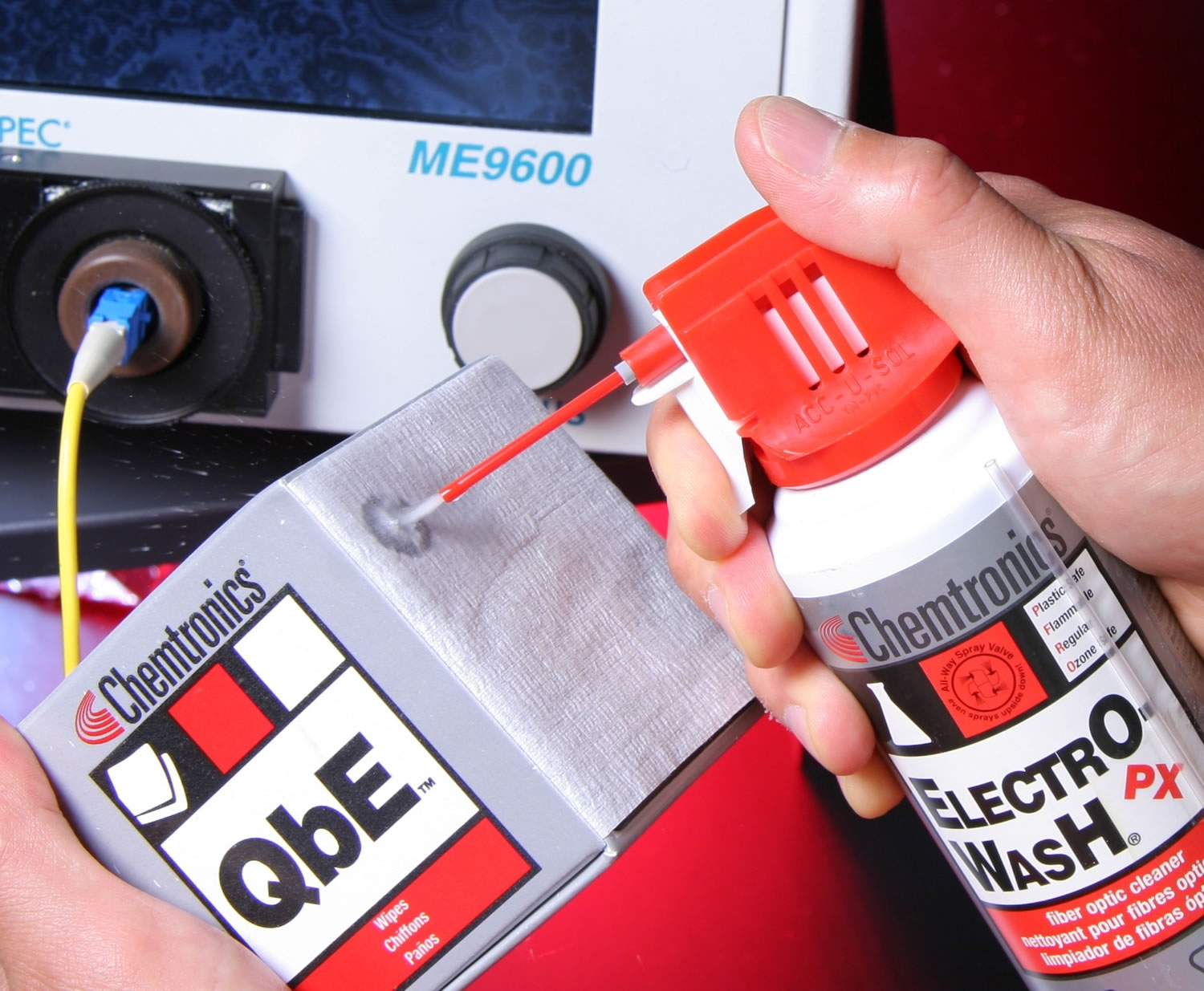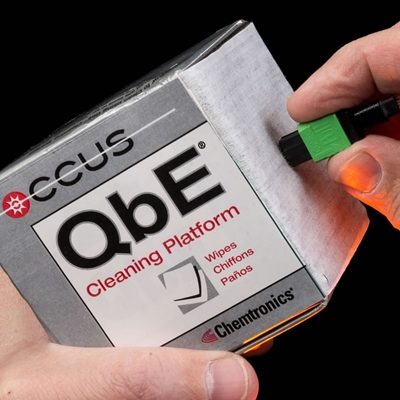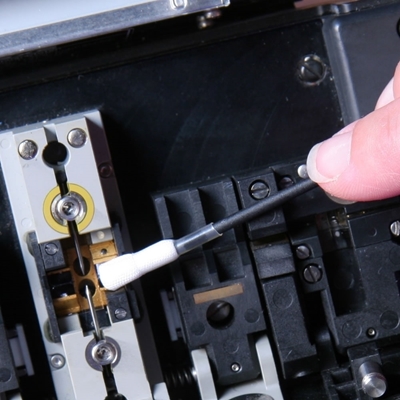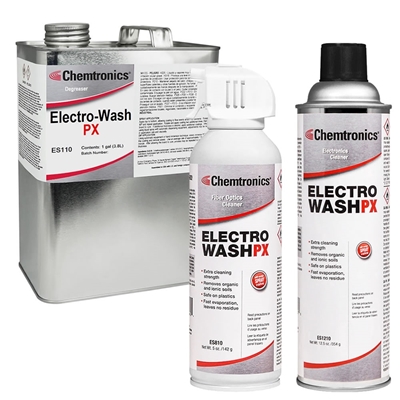In the
Below is a collection of best practices for the use of cleaning tools and procedures to get the best possible data throughput the 1st time... every time.
- Cleaning 2.5 mm Fiber Optic Connections
- Cleaning 1.25mm and 2.5mm Fiber Optic Backplane Connections using Precision Swabs
- Cleaning Angled Physical Connector (APC) End Faces with the QbE Cleaning System
- Cleaning Fusion Splice V-Grooves
- Precision Cleaning Fusion Splice Mirrors
Cleaning 2.5 mm Fiber Optic Connections
The need to clean fiber optic connectors is well documented. The more difficult operation is cleaning the “backplane” end face. This inaccessible end face, located on the backside of the alignment sleeve is subject to contamination from the patchcord connection. Airborne soils can accumulate around the ferrules in the alignment sleeve and will be transferred within the alignment sleeve to the patchcord ferrule. This occurs not only in field applications, but also in central office and OEM applications. Such contamination can cause signal attenuation or, in worst case reports, complete interruption of the signal.
- Disconnect the patch cord connections.
- The patchcord connection is effectively cleaned using a QbE Cleaning System.
- Pull one QbE Wipe over the Fiber-Safe neoprene platen
- Hold the end face at 90 degrees perpendicular to the platen
- Draw the end face lightly over the platen in a smooth linear motion
- Do not press too hard. Do not retrace your cleaning procedure in the same area.
- Do not use a figure-eight motion; do not use a “twist & turn” motionCheck your work with a fiber scope or a measuring device
- If using a solvent is necessary:
- Lightly “spot” the QbE wiper with Electro-Wash PX Degreaser (ES810)
- Draw the end face from the solvent wetted area to the dry area
- Check your work with a fiber scope or a measuring device
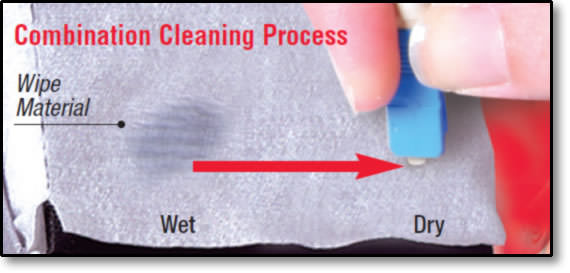
- With the patchcord removed from the bulkhead the backplane connector is cleaned effectively with Coventry 48040 Fiber Optic Cleaning Swab. Lightly moisten the swab by spotting a small amount of Electro-Wash PX into the QbE and dabbing the swab onto the wetted area. Insert the swab into the connector, press lightly against the connector, twist 2-3 times and remove. Dry with a second swab.
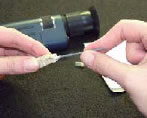
- Reinsert the patchcord and test for signal strength.
Cleaning 1.25mm and 2.5mm Fiber Optic Backplane Connections using Precision Swabs
The need to clean fiber optic connectors is well documented. The more difficult operation is cleaning the backplane end-face. This end-face, located on the backside of the alignment sleeve, is subject to contamination from the patch cord connection. The simple action of removing this connection can create a vacuum that enables airborne dust to enter this connection, causing soils to accumulate around the ferrules in the alignment sleeve. This contamination will then be transferred within the alignment sleeve to the patch cord ferrule. Clean both sides of these connections each time they are disconnected in field installations, central office and OEM installation, or service applications. Contamination can cause signal attenuation or, in worst-case reports, complete interruption of the signal.
When cleaning the backplane connection if the jumper on the internal side is accessible, it is preferred to clean both internal backplane and external ‘jumper-side’ connection. When the internal backplane connection is not accessible, highly effective cleaning is accomplished with the Coventry™ 1.25 mm Fiber Optic Swab (Part # 25123X), or the Coventry 2.5 mm Precision Fiber Optic Swab (25183) in combination with a small amount of Electro-Wash® PX Fiber Optic Cleaner. Alternatively, use of the Coventry 2.5 mm Fiber Optic Foam Swab in combination with a small amount of Electro-Wash PX Fiber Optic Cleaner will remove all contamination. It is important not to over-saturate the backplane by spraying or dipping any solvent on a precision swab. Excess solvent can accumulate and become exceptionally difficult to dry in the hidden areas of backplane connections.
- Remove the patch cord from the bulkhead.
- Lightly moisten the Fiber Optic Swab by spotting a small amount of Electro-Wash PX onto the QbE. Dab/tap the swab onto the wetted area. Hold the tip of the swab in the moist area for a count of 1-2-3-4-5.

- Insert the swab into the connector, press lightly against the connector, twist 2-3 times and remove.
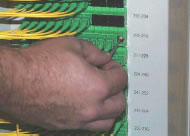
- Dry with a second swab.
- Reinsert the patch cord and test for signal strength. Re-clean as necessary.
Cleaning Angled Physical Connector (APC) End Faces with the QbE Cleaning System
Choosing the right cleaning solution is slightly more complex that simply using isopropyl alcohol (also known as IPA). IPA, especially in highest purities, is hygroscopic (absorbs moisture from the air). Ambient moisture attracted to IPA can attach to the connector end face. The drying procedures for residual alcohol, and ultimately residual moisture, are difficult at best. IPA does not adequately clean some non-ionic contaminants and can leave a thin layer of surface residue. Since isopropyl alcohol is relatively slow to dry, it can attract more airborne contamination leaving the surface more contaminated than before cleaning. Using excessive amounts of isopropyl alcohol can contribute to signal loss and “haloing”, which is believed to be residual alcohol and moisture contamination from inefficiently dried connectors.
The Chemtronics Combination Cleaning process begins with an optical review of the surface to be cleaned. Light oily hand soils can be safely removed using the QbE Cleaning System. Dust, airborne particles and other contaminants such as grease or buffer gel from soiled hands, are most safely removed using the combination of Electro-Wash PX Degreaser and the QbE. In those instances where visual inspection is not possible, the best practice method is to clean the end face with Electro-Wash PX in conjunction with QbE. This assures that statically charged dust particles and complex soils are safely removed.
APC’s present a unique cleaning challenge. End face cleaning requires the technician to position the surface to be cleaned at the correct perpendicular angle. With the APC this is somewhat problematic when using a small cleaning surface. This requires the technician to “find the angle”, with a tactile motion of the surface to be cleaned positioned against the cleaning surface. In those instances where the soil is unknown or contains dust, the end face can be damaged if it is cleaned “dry”.
The large cleaning surface of the QbE, in conjunction with the solvency of Electro-Wash PX Degreaser, offers the technician the dual advantage of a large, safe cleaning surface as well as the superior cleaning ability of both ionic and non-ionic contaminants. This process is known as the Combination Cleaning process.
- Pull one QbE Wipe over the Fiber-Safe platen.
- Spray a small amount of Electro-Wash PX Degreaser in one corner of the wipe. A small spot about 1” in diameter works best.
- Hold the end face at 90 degrees perpendicular to the platen for standard polish end face. “Find the Angle” by lightly drawing the APC or standard connection from wet to dry.
- Draw the end face lightly over the platen in a smooth linear motion. Don’t twist and turn, or use a figure-8 polishing action to clean end faces.
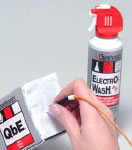
- Do not press too hard, and do not retrace your cleaning procedure over the same area.
- Check your work with a fiberscope or measuring device.
Cleaning Fusion Splice V-Grooves
When cleaning the alignment grooves (or v-grooves) on a fusion splicer many technicians will use an alcohol presaturated wipe to remove the contamination. If the contamination is not removed, it can be incorporated in the splice, causing decreased transmission of the fiber, or a total blocked signal. Also, the common practice of using a cotton swab for this precision application can leave lint residue. Rarely is an alcohol wipe or cotton swab capable of a good cleaning job in this application.
Coventry 38540 swab offers the technician a better tool to clean the contamination directly out of the alignment groove without leaving any lint or residual alcohol from an oversaturated pad. The swab can be used dry for removing mild contamination, or slightly wetted with Electro-Wash PX Degreaser to remove stubborn contamination. Simply wipe the edge of the swab in the v-groove to remove the contaminants. To lightly wet the 38540 swab, spray a small amount of the Electro-Wash PX onto a lint free wipe, such as the QbE Cleaning Platform or Coventry 6704 Lint Free Wipes. Tap the swab head into the wiper and lightly moisten.
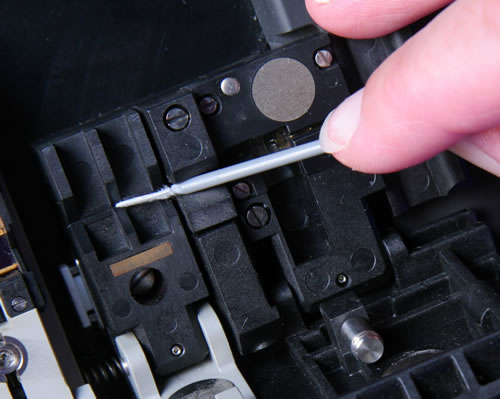
Precision Cleaning Fusion Splice Mirrors
The need to clean Fiber Optic equipment is oftentimes not as detailed as cleaning End Face and connection geometry. However, soiled physical components of fusion splice equipment, connections on OTDR and other measurement tools can affect performance of these precision devices.
Historically precision components on fusion splice equipment were cleaned with cotton tips and “low-lint” paper wipers. These materials have the deleterious potential of leaving contaminants on surfaces that must be completely lint or contaminant free to perform to high -test standards.
Drawing on cleanroom standard materials, the Coventry 51121 is constructed of highest quality non-linting polyester. The material will clean fusion splice mirrors without leaving lint residue associated with any cotton tip.
- Always refer to manufacturer’s specific instructions before cleaning.
- Lightly pass the Coventry 51121 over the reflection mirror. Observe the mirror to assure there is no lint or other contaminant.
- Do not use a solvent unless specifically approved for your model fusion splicer by the manufacturer of the device. Some mirrors can have a protective coating, which can be damage by improper use or over use of a solvent.
- IF a solvent is approved, lightly moisten the 51121 swab with the solvent. DO NOT OVER SATURATE. Dry with a second 51121 swab for maximum performance.
- Use a Coventry 6704 Lint Free Wipe with ITW Chemtronics CP410 for cleaning of key pads and other surfaces. ITW Chemtronics CP400 is a high quality IPA solvent source for cleaning mirrors.
